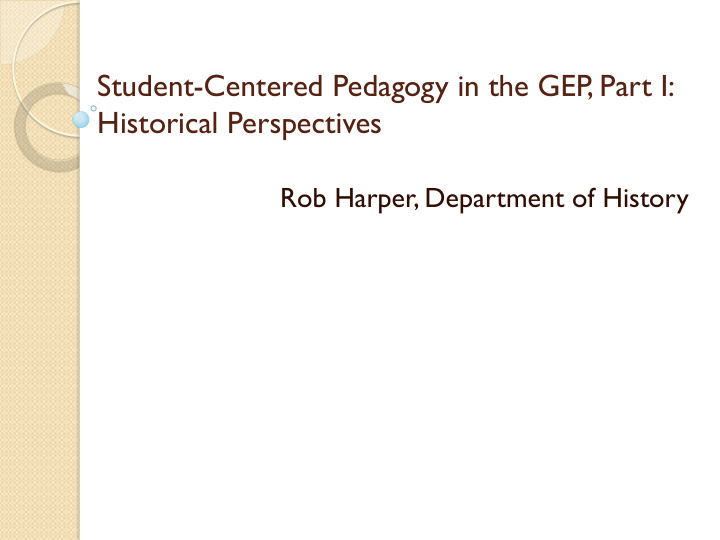



Student-Centered Pedagogy in the GEP , Part I: Historical Perspectives Rob Harper, Department of History
Before creating first-year seminar, ask: “What should be the educational character of the first year of college?” - Vincent Tinto, Syracuse University
Keys to student success GEP surveys at UWSP High expectations Sections of 40+ students Academic and social Large rooms, fixed seating support Few assignments Frequent feedback Stand-alone courses Active involvement Support available – to Relevant learning those who seek it What should be the educational character of the first year of college, given our structural constraints?
Prepping My Old History Survey What will I cover? ◦ Which textbook? ◦ What lectures? ◦ Added color? How will I make them read and show up? What will I put on the exam?
My Goals Students’ Reality Complexity of the past Cramming and forgetting Improved reading Minimal reading Critical thinking Just tell us the facts! Exam = necessary evil Exam = all that matters Learning for all Sheep vs. goats What should be the educational character of a history survey course, given our structural constraints?
SoTL in History Learning by DOING history Active practice, not static knowledge Skill-centered, not content-centered “Historical thinking” ◦ Interpreting evidence ◦ Critically examining arguments But… most of these recommendations come from folks who teach small classes.
T eaching History for Critical Reading Identify core critical reading skills Emphasize skill development throughout Create narrowly focused, guided reading assignments Closely integrate assignments, lesson plans, and assessment
What is “critical reading”? Questioning Sourcing Connecting Analyzing Evaluating
Roadmaps for Reading: Worksheets Guide students through the assignment Target specific component skills Introduce transferable study strategies Normalize idiosyncrasy, confusion, and learning
Sample worksheets “Telling the Truth about Textbooks” (pink) ◦ Unit 1: ideas about the past change ◦ Noticing differences between texts “Childhood in Early New England” (yellow) ◦ Unit 2: interpreting primary sources ◦ Questioning and sourcing “Antebellum Plantation” (green) ◦ Unit 3: understanding secondary sources ◦ Analyzing
How do worksheets work? Alphabetized folders & scanning Graded pass/fail Diminishing frequency Integrated with lecture, discussion, in-class small-group work
A student-centered journey Where will my students go? ◦ College-level critical reading Why should they buy into going? ◦ Transferability of skills; relevance of questions How will they get there? ◦ Focused content; worksheets; group work How will they show how far they’ve gotten? ◦ Skill-centered examinations
Recommend
More recommend